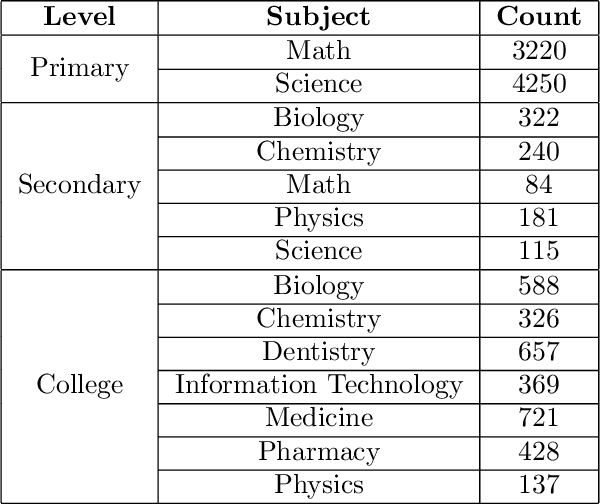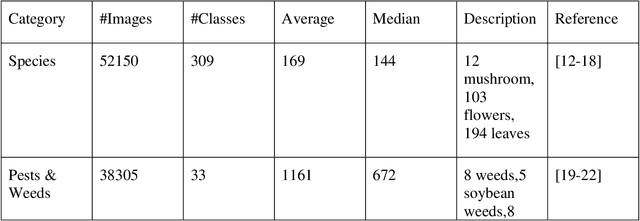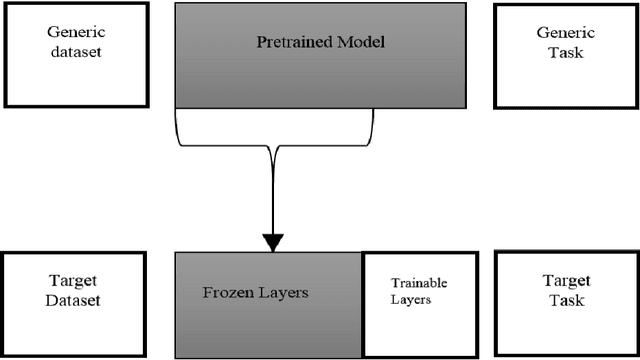Mariette Awad
AraSTEM: A Native Arabic Multiple Choice Question Benchmark for Evaluating LLMs Knowledge In STEM Subjects
Dec 31, 2024



Abstract:Large Language Models (LLMs) have shown remarkable capabilities, not only in generating human-like text, but also in acquiring knowledge. This highlights the need to go beyond the typical Natural Language Processing downstream benchmarks and asses the various aspects of LLMs including knowledge and reasoning. Numerous benchmarks have been developed to evaluate LLMs knowledge, but they predominantly focus on the English language. Given that many LLMs are multilingual, relying solely on benchmarking English knowledge is insufficient. To address this issue, we introduce AraSTEM, a new Arabic multiple-choice question dataset aimed at evaluating LLMs knowledge in STEM subjects. The dataset spans a range of topics at different levels which requires models to demonstrate a deep understanding of scientific Arabic in order to achieve high accuracy. Our findings show that publicly available models of varying sizes struggle with this dataset, and underscores the need for more localized language models. The dataset is freely accessible on Hugging Face.
An Unsupervised Anomaly Detection in Electricity Consumption Using Reinforcement Learning and Time Series Forest Based Framework
Dec 30, 2024Abstract:Anomaly detection (AD) plays a crucial role in time series applications, primarily because time series data is employed across real-world scenarios. Detecting anomalies poses significant challenges since anomalies take diverse forms making them hard to pinpoint accurately. Previous research has explored different AD models, making specific assumptions with varying sensitivity toward particular anomaly types. To address this issue, we propose a novel model selection for unsupervised AD using a combination of time series forest (TSF) and reinforcement learning (RL) approaches that dynamically chooses an AD technique. Our approach allows for effective AD without explicitly depending on ground truth labels that are often scarce and expensive to obtain. Results from the real-time series dataset demonstrate that the proposed model selection approach outperforms all other AD models in terms of the F1 score metric. For the synthetic dataset, our proposed model surpasses all other AD models except for KNN, with an impressive F1 score of 0.989. The proposed model selection framework also exceeded the performance of GPT-4 when prompted to act as an anomaly detector on the synthetic dataset. Exploring different reward functions revealed that the original reward function in our proposed AD model selection approach yielded the best overall scores. We evaluated the performance of the six AD models on an additional three datasets, having global, local, and clustered anomalies respectively, showing that each AD model exhibited distinct performance depending on the type of anomalies. This emphasizes the significance of our proposed AD model selection framework, maintaining high performance across all datasets, and showcasing superior performance across different anomaly types.
On The Potential of The Fractal Geometry and The CNNs Ability to Encode it
Jan 07, 2024Abstract:The fractal dimension provides a statistical index of object complexity by studying how the pattern changes with the measuring scale. Although useful in several classification tasks, the fractal dimension is under-explored in deep learning applications. In this work, we investigate the features that are learned by deep models and we study whether these deep networks are able to encode features as complex and high-level as the fractal dimensions. Specifically, we conduct a correlation analysis experiment to show that deep networks are not able to extract such a feature in none of their layers. We combine our analytical study with a human evaluation to investigate the differences between deep learning networks and models that operate on the fractal feature solely. Moreover, we show the effectiveness of fractal features in applications where the object structure is crucial for the classification task. We empirically show that training a shallow network on fractal features achieves performance comparable, even superior in specific cases, to that of deep networks trained on raw data while requiring less computational resources. Fractals improved the accuracy of the classification by 30% on average while requiring up to 84% less time to train. We couple our empirical study with a complexity analysis of the computational cost of extracting the proposed fractal features, and we study its limitation.
An Asymmetric Loss with Anomaly Detection LSTM Framework for Power Consumption Prediction
Feb 05, 2023Abstract:Building an accurate load forecasting model with minimal underpredictions is vital to prevent any undesired power outages due to underproduction of electricity. However, the power consumption patterns of the residential sector contain fluctuations and anomalies making them challenging to predict. In this paper, we propose multiple Long Short-Term Memory (LSTM) frameworks with different asymmetric loss functions to impose a higher penalty on underpredictions. We also apply a density-based spatial clustering of applications with noise (DBSCAN) anomaly detection approach, prior to the load forecasting task, to remove any present oultiers. Considering the effect of weather and social factors, seasonality splitting is performed on the three considered datasets from France, Germany, and Hungary containing hourly power consumption, weather, and calendar features. Root-mean-square error (RMSE) results show that removing the anomalies efficiently reduces the underestimation and overestimation errors in all the seasonal datasets. Additionally, asymmetric loss functions and seasonality splitting effectively minimize underestimations despite increasing the overestimation error to some degree. Reducing underpredictions of electricity consumption is essential to prevent power outages that can be damaging to the community.
Spatio-Temporal Graph Neural Networks: A Survey
Jan 25, 2023Abstract:Graph Neural Networks have gained huge interest in the past few years. These powerful algorithms expanded deep learning models to non-Euclidean space and were able to achieve state of art performance in various applications including recommender systems and social networks. However, this performance is based on static graph structures assumption which limits the Graph Neural Networks performance when the data varies with time. Temporal Graph Neural Networks are extension of Graph Neural Networks that takes the time factor into account. Recently, various Temporal Graph Neural Network algorithms were proposed and achieved superior performance compared to other deep learning algorithms in several time dependent applications. This survey discusses interesting topics related to Spatio temporal Graph Neural Networks, including algorithms, application, and open challenges.
CEnt: An Entropy-based Model-agnostic Explainability Framework to Contrast Classifiers' Decisions
Jan 19, 2023Abstract:Current interpretability methods focus on explaining a particular model's decision through present input features. Such methods do not inform the user of the sufficient conditions that alter these decisions when they are not desirable. Contrastive explanations circumvent this problem by providing explanations of the form "If the feature $X>x$, the output $Y$ would be different''. While different approaches are developed to find contrasts; these methods do not all deal with mutability and attainability constraints. In this work, we present a novel approach to locally contrast the prediction of any classifier. Our Contrastive Entropy-based explanation method, CEnt, approximates a model locally by a decision tree to compute entropy information of different feature splits. A graph, G, is then built where contrast nodes are found through a one-to-many shortest path search. Contrastive examples are generated from the shortest path to reflect feature splits that alter model decisions while maintaining lower entropy. We perform local sampling on manifold-like distances computed by variational auto-encoders to reflect data density. CEnt is the first non-gradient-based contrastive method generating diverse counterfactuals that do not necessarily exist in the training data while satisfying immutability (ex. race) and semi-immutability (ex. age can only change in an increasing direction). Empirical evaluation on four real-world numerical datasets demonstrates the ability of CEnt in generating counterfactuals that achieve better proximity rates than existing methods without compromising latency, feasibility, and attainability. We further extend CEnt to imagery data to derive visually appealing and useful contrasts between class labels on MNIST and Fashion MNIST datasets. Finally, we show how CEnt can serve as a tool to detect vulnerabilities of textual classifiers.
Beyond Model Interpretability: On the Faithfulness and Adversarial Robustness of Contrastive Textual Explanations
Oct 17, 2022



Abstract:Contrastive explanation methods go beyond transparency and address the contrastive aspect of explanations. Such explanations are emerging as an attractive option to provide actionable change to scenarios adversely impacted by classifiers' decisions. However, their extension to textual data is under-explored and there is little investigation on their vulnerabilities and limitations. This work motivates textual counterfactuals by laying the ground for a novel evaluation scheme inspired by the faithfulness of explanations. Accordingly, we extend the computation of three metrics, proximity,connectedness and stability, to textual data and we benchmark two successful contrastive methods, POLYJUICE and MiCE, on our suggested metrics. Experiments on sentiment analysis data show that the connectedness of counterfactuals to their original counterparts is not obvious in both models. More interestingly, the generated contrastive texts are more attainable with POLYJUICE which highlights the significance of latent representations in counterfactual search. Finally, we perform the first semantic adversarial attack on textual recourse methods. The results demonstrate the robustness of POLYJUICE and the role that latent input representations play in robustness and reliability.
On the Explainability of Natural Language Processing Deep Models
Oct 13, 2022



Abstract:While there has been a recent explosion of work on ExplainableAI ExAI on deep models that operate on imagery and tabular data, textual datasets present new challenges to the ExAI community. Such challenges can be attributed to the lack of input structure in textual data, the use of word embeddings that add to the opacity of the models and the difficulty of the visualization of the inner workings of deep models when they are trained on textual data. Lately, methods have been developed to address the aforementioned challenges and present satisfactory explanations on Natural Language Processing (NLP) models. However, such methods are yet to be studied in a comprehensive framework where common challenges are properly stated and rigorous evaluation practices and metrics are proposed. Motivated to democratize ExAI methods in the NLP field, we present in this work a survey that studies model-agnostic as well as model-specific explainability methods on NLP models. Such methods can either develop inherently interpretable NLP models or operate on pre-trained models in a post-hoc manner. We make this distinction and we further decompose the methods into three categories according to what they explain: (1) word embeddings (input-level), (2) inner workings of NLP models (processing-level) and (3) models' decisions (output-level). We also detail the different evaluation approaches interpretability methods in the NLP field. Finally, we present a case-study on the well-known neural machine translation in an appendix and we propose promising future research directions for ExAI in the NLP field.
On the Evaluation of the Plausibility and Faithfulness of Sentiment Analysis Explanations
Oct 13, 2022Abstract:Current Explainable AI (ExAI) methods, especially in the NLP field, are conducted on various datasets by employing different metrics to evaluate several aspects. The lack of a common evaluation framework is hindering the progress tracking of such methods and their wider adoption. In this work, inspired by offline information retrieval, we propose different metrics and techniques to evaluate the explainability of SA models from two angles. First, we evaluate the strength of the extracted "rationales" in faithfully explaining the predicted outcome. Second, we measure the agreement between ExAI methods and human judgment on a homegrown dataset1 to reflect on the rationales plausibility. Our conducted experiments comprise four dimensions: (1) the underlying architectures of SA models, (2) the approach followed by the ExAI method, (3) the reasoning difficulty, and (4) the homogeneity of the ground-truth rationales. We empirically demonstrate that anchors explanations are more aligned with the human judgment and can be more confident in extracting supporting rationales. As can be foreseen, the reasoning complexity of sentiment is shown to thwart ExAI methods from extracting supporting evidence. Moreover, a remarkable discrepancy is discerned between the results of different explainability methods on the various architectures suggesting the need for consolidation to observe enhanced performance. Predominantly, transformers are shown to exhibit better explainability than convolutional and recurrent architectures. Our work paves the way towards designing more interpretable NLP models and enabling a common evaluation ground for their relative strengths and robustness.
* 13 pages, 3 figures, conference (AIAI - springer)
The Power of Transfer Learning in Agricultural Applications: AgriNet
Jul 17, 2022



Abstract:Advances in deep learning and transfer learning have paved the way for various automation classification tasks in agriculture, including plant diseases, pests, weeds, and plant species detection. However, agriculture automation still faces various challenges, such as the limited size of datasets and the absence of plant-domain-specific pretrained models. Domain specific pretrained models have shown state of art performance in various computer vision tasks including face recognition and medical imaging diagnosis. In this paper, we propose AgriNet dataset, a collection of 160k agricultural images from more than 19 geographical locations, several images captioning devices, and more than 423 classes of plant species and diseases. We also introduce AgriNet models, a set of pretrained models on five ImageNet architectures: VGG16, VGG19, Inception-v3, InceptionResNet-v2, and Xception. AgriNet-VGG19 achieved the highest classification accuracy of 94 % and the highest F1-score of 92%. Additionally, all proposed models were found to accurately classify the 423 classes of plant species, diseases, pests, and weeds with a minimum accuracy of 87% for the Inception-v3 model.Finally, experiments to evaluate of superiority of AgriNet models compared to ImageNet models were conducted on two external datasets: pest and plant diseases dataset from Bangladesh and a plant diseases dataset from Kashmir.
 Add to Chrome
Add to Chrome Add to Firefox
Add to Firefox Add to Edge
Add to Edge